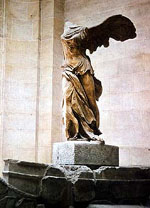
How about some background first....
Hellenistic sculpture refers to a period of sculpture that is, well...Greek or Greek-like. Greeks didn't call themselves greek, that's what romans called greeks, and the Greeks weren't very happy about but hey the Romans were in charge so what are you going to do? I mean, who picks your titles? your Boss or you? You get the point. (BTW Egyptians didn't call themselves egyptians, Byzantines didn't call themselves Byzantines and Gauls didn't call themselves Gauls either. Romans did call themselves Romans however, but then so did the Byzantines. One thing everyone should know is that the names we use in art history are more or less wrong...their just arbitrary names we use for convienience. We could just as accurately call the Greeks, "those vase making guys" and be just as accurate. What Greeks actually called themselves, and still do...Hellenes...hence...hellenistic art. Once upon a time there was this Greek guy named Alexander, and he was pretty great, or so he thought, so he conquered a whole chunk of the earth, and made Greek art all the vogue and spread Hellenic art, that is greek art made by greeks, all over the place. Eventually Alexander died from a drinking binge, true story, and the greeks left, but the art stayed. Then we have Hellenistic art, that is greek-like art not necessarily made by greeks, but by people who just think its cool stuff to dress up a homestead. Hellenistic art is a lot different than the art made by earlier Greeks, which is more or less called "Classical" Classical sculpture has very formalized poses and set rules on proportions and gestures...or in other words...boring. Hellenistic art is a lot more dramatic and fun. We see a lot more action and emotion. It's always great fun to watch people look at art. Most Classical stuff, they look at straight on, pause, ponder and move on. But at the Hellenistic stuff you see them standing on their toes, craning necks, even crouching down and walking all around the sculpture, there is just so much to see and so many different angles to see it from.
Now back to Nike...Nike was the greek - please ignore this use of an arbitraty title - goddess of victory. She spreads her wings just as she lands on top of the prow of a ship. Long ago, when she still had arms and a head, she and the prow were part of some Massive war memorial the Samothracians put up to commemerate a sea battle. We assume they must've one because, well...there she is on the prow, instead of the goddess of defeat which looks uncannily like Baby Spice...just kidding. What amazes people most about this sculpture I think is the way it captures the physical action. Despite the fact that it is made of stone, the sculpture floats down, its wings spread, as if it just landed on the prow, you can see the wind of the moving vessel blowing back her fluttering dress. It's a spectacular scene. Oddly, the loss of her arms and head allows us to appreciate the skill of the sculptor in rendering the torso and drapery, without the distraction of looking at all those superfluous body parts.
Not that I'd reccommend hacking the arms off all those other nice greek statues.
Take care and have a nice day from the IOD!!